Century of Endeavour
The Family in the 1900s
(c) Roy Johnston 1999
(comments to rjtechne@iol.ie)
The Johnston Family
The eldest son James was born on November 24 1874, then was a daughter Mary Ann, March 13 1877, who died; the second son Samuel Alexander (Sam) was born on December 25 1880, the third John April 15 1883. Then came William Henry (Harry) on December 17 1885, then William on May 13 1888. My father Joe was born on August 2 1890, and then a second daughter Ann Elizabeth (Aunt Annie), who survived, born on November 10 1897.I am indebted to Willie O'Kane and Eoin Kerr of Heritage World in Dungannon for these dates. They were well spaced, due probably to the practice of breast-feeding. This enabled the financial load of their education to be spread out over a long time, with the elder ones subsidising the younger from salaried jobs. This JJ's elder brother James spent from 1896 to 1901 in Oxford, John from 1901 to 1905 and William from 1907 to 1910. The family resources were able to support them one at a time in Oxford.
In what follows I tell what I have found out, and conjecture, about the houses and the schooling of the Johnstons; details about the Wilson side of the family are in the overview of the 'family' thread. I also expand on what I know about the elder brothers.
Johnston Residences
The farm at Tomagh had been John Johnston's home for at least the duration of his teaching career; it is in walking distance of the schools at Tullyarran and Kilnaslee. When he retired in 1897, it was evident that none of the family wanted to stay on in farming; most were well on their way into their various professions. So by degrees old John disposed of the lease, which was from the Earl of Charlemont, renting a house in Dunamoney Wood, which is some distance to the south, closer to, and in walking distance of, Castlecaulfield, to which parish they belonged. This move took place I think around 1906; Anne remembered it and identified the house in the 1960s to Winnie Acheson.
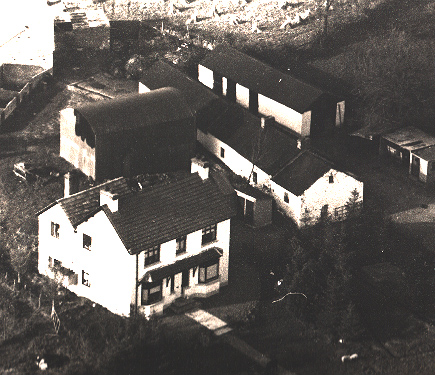
The timing of the move probably was related to James, Sam and John becoming established as earners, and sending money home. The house is somewhat more prosperous looking than that at Tomagh. If this move took place much before 1906 it would have posed the problem of how JJ could have got into Dungannon to school; it is some distance from the town. If the move took place while JJ was still at DRS he might been a weekly boarder, but my sister thinks this is improbable. Ann would then still have been at the local primary school.
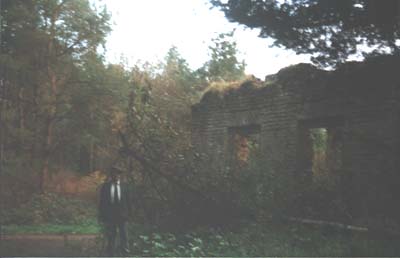
The rented house at Dunamoney Wood is now a ruin, in the middle of a forestry plantation of recent origin; there are signs of an earlier wooded environment, and related farm buildings.
According to Winnie Acheson, Anne, who was born in 1897, remembered Tomagh when small, so it is likely that they moved to Dunamoney Wood some years after old John's retirement.
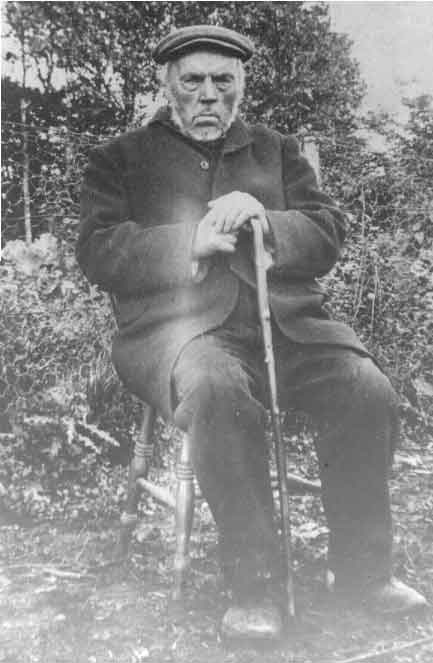
This photo of old John Johnston was probably taken towards the end of his days, near the rented house at Dunamoney Wood.
Joe had recollection of helping with farm work, so I conjecture that they stayed on in Tomagh farming until 1906. Old John was by then into his 70s, and none of the sons was in a position to take it on. Willie O'Kane in the Dungannon Heritage Centre has identified an initial lease transfer in 1900 to William Hamilton, and then a further one in 1908 to Ralph Hamilton. This latter must have included the final disposal of the Tomagh farmhouse.
The last links with Tomagh were cut in 1908, but it is of interest to note that the present owner of the land, in whose farmyard the old house remains in existence as an outbuilding, retains a vestige of the link, in that the modern farmhouse, as seen from the air photograph above, is called 'Johnstonville'.
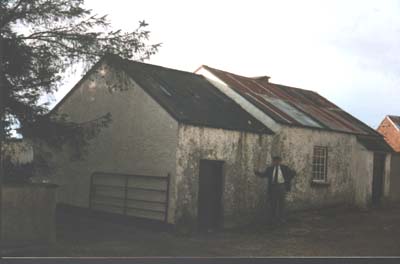
What remains of the house at Tomagh is now an outbuilding in the Kelly farmyard.
With the disposal of the Tomagh lease, and perhaps remittances from one or more of the elder sons, they would have had the resources to rent a more comfortable house, as Dunamoney Wood clearly was. It is probable that they stayed on in Dunamoney Wood until old John died, as he would probably have preferred to remain close to the Castlecaulfield parish, where he had strong links, having served on the Committee. Thus the final move to Bessmount would have involved only Mary Geddes and Ann, as Joe by then was in college in Dublin. The ruins of this house can still be seen, to the northwest of the hospital; it is more extensive than the Dunamoney Wood house, and substantially better than Tomagh. My sister remembers the name Bessmount, as being the place from which our grandmother and Aunt Ann came when they finally moved to Dublin.
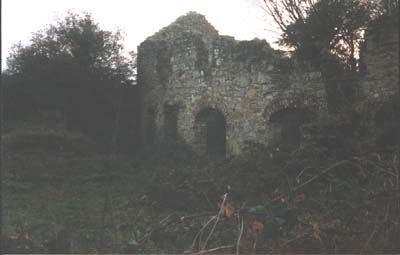
The house at Bessmount, in the townland of Ranaghan, to the north-east of Dungannon, near the hospital, is also now a ruin; according to local lore it was occupied by the military in the 1940s and was left beyond repair.
My aunt Anne remembered Tomagh when small, as well as the Dunamoney and Bessmount houses; she went over the ground with Winnie Acheson in the 1960s. Bessmount however according to local knowledge (the Curran family nearby) was owned and occupied by families named Reid and then Wiggins. The ruins show signs of having had a yard and mews, so it is probable that what remained of the Johnston family, basically my grandmother, JJ and Ann, rented a mews flat, or maybe part of the house, perhaps in a caretaking role. Winnie Acheson remembers distinctly Bessmount as having been the name of the house, as pointed out by Ann.
JJ went up to Trinity College in 1906 and the household would then during term have been reduced to my grandparents and Anne, then aged 9. Old John died in December 1909, after which the final move took place to Bessmount, where it is probable that my grandmother had a caretaking arrangement with the occupants; there is visible in the ruins what could have been a courtyard with a mews.
This was the base for Ann's schooling and college career, and JJ's, until Anne got her civil service job in Dublin, when Mary Geddes came to join the family in Dublin in or about 1920. By this time JJ had given up the flat in Fitzwilliam Square, and was renting a house in Ranelagh called Santoy, where Sam joined them for his last illness, with the three boys. This extreme pressure on housing space led to a nervous breakdown for my mother, and prompted the move to Stillorgan in 1921.
James
JJ's eldest brother James was born on 24 November 1874 in Donaghmore,
County Tyrone, and was educated at the Royal Academical Institution, Belfast and Queen's College, Galway, from which he went on to Merton College Oxford in 1896. He went on to join the Indian Civil Service. So old John must have been living at Donaghmore before the move to Tomagh. This would tally with teaching at Tullyarran. He probably moved to Tomagh when he took up teaching at Kilnaslee.
The Oxford record has it that 'James Johnston matriculated from Merton College on 1 February 1896. The first son of John Johnston, farmer of Tomagh, Castlecaulfield, he was born on 24 November 1874 in Donaghmore, County Tyrone, and was previously educated at the Royal Academical Institution, Belfast and Queen's College, Galway. He obtained second class honours in Classical Moderations in 1897 and passed groups A1 (Greek Philosophy and Greek or Latin History), B1 (English History and Literature, or Modern European History or Indian History with Political and Descriptive Geography) and B3 (the Elements of Political Economy) of the final Pass School in Michaelmas Term 1901. The degrees of BA and MA were conferred on him on 21 June 1906.'
The influence of the elder brothers in the Indian Civil Service probably was significant. Family lore has it that James was influential in the writing of Civil War in Ulster. His Queens College Galway degree was the norm for many Northern Protestants at a time when the Hierarchy was opposed to the 'Godless Colleges'. He had an all-Ireland perspective, as indeed was the norm among Irish Protestants at the time.
Sam
I have no record of Sam, but he and Harry went to medical school, it would seem probably in Edinburgh, according to JJ in his Seanad 1940s speeches, and then together into practice in Newcastle-on-Tyne. Sam died young, of TB, according to my sister at Santoy in Ranelagh, in or about 1920, though it seems he moved to Newcastle sanitorium in Wicklow for his final days; he is buried there. His widow Lizzie went back to England where she worked as a nurse, to help support them.(The Garnier correspondence mentions the presence of a brother of JJ in 1921 when they were in Stillorgan, but it turns out that this could not have been Sam; it must have been one of the Indian Civil brothers on leave.)
There are no school records for James or Sam, the DRS archive being incomplete. There are records however for John, Harry and William. The detailed record begins circa 1900, by which time Sam would have gone on to medical school, probably College of Surgeons in Dublin.
John
The third brother John was born on 14 April 1883 in Tomagh, in the parish of Castlecaulfield, and was educated at the Royal School, Dungannon, going on in this case directly to Merton College Oxford. He is on record in the local press Honours List for 1903, at the same time as William achieved Middle Grade honours, as having won a Goldsmith Scholarship for Oxford worth £50 for 3 years.
In the Dungannon Royal School records, for access to which I am indebted to Norman Cardwell, here are prize records and press report for the 1890s: according to the Belfast Newsletter 21/12/96 John got a £20 exhibition for 3 years in junior grade, meriting a mention in headmaster R F Dill's speech. On 22/12/99 John again gets a mention for getting the Royal University of Ireland matriculation, and a £24 exhibition, along with classical scholarships in RUI. He gets a further mention on 21/12/00 as winning the first classical scholarship to Queens University Belfast, and then on 20/12/01 as well as a £30 exhibition in Queens he gets a scholarship to Merton College Oxford.
His Indian Civil Service exam results are given in the Irish Times (October 1905); There is also a record in the local press in October 1905, headed 'Success of Ulster Student', which records his Indian Civil Service results, and credits him with holding scholarships in both Queens and the Royal Universities. He is also said to have gained a 'post-mastership for £80 for 4 years in Merton'. There is some inconsistency between these reports, but they both probably conflate to the one John Johnston my uncle.
According to the Oxford record, 'John Johnston matriculated from Merton College on 15 October 1901. The third son of John Johnston (described as `ex-National School teacher' in this case), he was born on 14 April 1883 in Tomagh and was previously educated at the Royal School, Dungannon. He obtained second class honours in Classical Moderations in 1903 and first class honours in Literae Humaniores in 1905. The degree of BA was conferred on him on 21 October 1905 and that of MA on 12 November 1910.'
John is on record in the Merton Debating Society minutes between 1902 and 1905, and in the Bodley Club between May 1902 and November 1903, after which he seems to have concentrated on the Debating Society, of which he eventually became President.
In his Bodley period he was an active participant, reading a paper on Kipling on Nov 14 1902, in which he compared his imperialism to that of the French, while disapproving of his merrymaking in Ireland, 'preferring boycotting and similar quiet fun'. This suggests a family awareness of the land agitations, and support for the Land League position.
There is evidence of a laconic wit in the short entries relating to John. He admired Samuel Johnson as a critic but not as a thinker or writer, and later compared MacAulay to Aeschylus. In response to a learned paper on French poetic metres, by one Stone from Christchurch (May 29 1903) John found limericks much more useful; no doubt he regaled the company with some. On June 12 one HJ Thompson read a paper on Goldsmith, in response to which John accused Goldsmith of creating a false impression of Irish character, and therefore of being responsible for an evil political influence.
John was elected to the Committee of the Bodley Society, and in Michaelmas term 1903 in response to a paper by one Dawson on William Morris attacked the latter as being 'no poet, and no social reformer either, as his reforms could apply only to men of wealth and culture..'. Then on November 13 1903 John read a paper on Samuel Lover, author of Rory O'Moore and Widow Machree; he drew comparisons with Charles Lever and William Carleton. There was an obscure reference to Handy Andy.
John seems after this to have dropped out of the Bodley Society, sensing perhaps that his concern for Irish culture and politics was not going down well. He stood for secretary for the next session, but seems to have failed, as he disappears from the record.
He was active in the Debating Society from where the available record begins in November 1902, speaking at two of the three debates in the Michaelmas term. Then on December 9 he was elected Secretary, AB Wheatfield being President, taking over in January 1903. In his recorded contributions he approved of anonymous journalism, regarded millionaires as the curse of modern society, and disapproved of modern poetry as being too emotional.
John became President of the Society in Michaelmas term 1903, and as such presumably had a say in the wording of the motions. The Society declined to approve of Chamberlain's fiscal policy, declined to condemn athletics as excessive and dangerous, but agreed on the need to stem rural depopulation in England. The motion 'that the Oxford outlook on life was artificial and narrow' was defeated narrowly on the Chairman's casting vote. This indicates that the wording of the motion does not necessarily reflect the Chairman's opinion. Perhaps it should have, for on November 23 a vote of censure on the President was proposed, and narrowly rejected at the subsequent meeting on November 30. At these meetings they declined to condemn the current system of education of the masses, and declared 'the policy adopted by the passive resisters (to be) unjustifiable'. (This presumably related to the suffragettes? The context is not clear from the record.)
On December 7 they supported Solomon's judgment regarding the rod and the child. John is not on record in any of the debates during his presidential term. In the following term (1904) he is on record frequently, opposing criticism of party politics (February 1), and supporting the re-introduction of slavery (February 8). I suspect here a Swiftian 'Modest Proposal' type of argument; I did something similar myself in an article in the 'Plough' in or about 1959 ('Humans on the Hoof'), suggesting that, if we invest so much in educating our graduates only to export them, we should at least get paid for them! He also supported war as necessary for peace, but went on record on February 22, along with a big majority, his opposition to the introduction of Chinese labour to South Africa.
During this period he was active in trying to reform the procedures by imposing a speakers panel, with less frequent meetings; he was unsuccessful. They did agree to use private business for identifying topics for debate. On February 29 they decided that the prison system did not deter or improve, John supporting. After this, John drops out of sight.
I have spent some time with John because the record is there (I can find nothing much on James or William) and also because it indicates something of the flavour of the early influences on JJ, of a sequence of elder brothers who were energetic and articulate, and who were alive to the existence of Irish culture as a distinct entity, while being eventually committed to serve the Empire.
Harry
Harry (whose full name was William Henry) took a medical degree; it is not on record where he went, but my sister thinks he went to the College of Surgeons in Dublin. This however would be difficult to reconcile with the fact that he ended up practising as a general practitioner in London, after a period in Newcastle with Sam. According to the school records in Norman Cardwell's possession, there seems to have been a tradition of going to Edinburgh from DRS for medical education, and this would be consistent with setting up in Britain.Harry influence on JJ was minimal, though we did pay a family visit in 1939, on the principle that JJ felt we should all see London before Hitler destroyed it. (This is developed in the 1930s module of the 'family' stream).
Compared to John and William the Dungannon Royal School record for Harry is sparse. He did achieve a reference in a Headmaster Dill prize-day speech, reported in the Belfast Newsletter of 22/12/1899, for winning a £20 exhibition in preparatory grade. The Intermediate results for 1902 show achieving middle grade, with good honours marks in Greek, Latin, French and Maths, though English was poor. He is allowed to retain his junior grade exhibition.
William
William was born on 23 May 1888, also in Tomagh, and was educated at the Royal School, Dungannon, to which he won in 1900 a preparatory grade exhibition worth £20. In the 1902 Intermediate Board exams he did honours in six subjects, doing well in classics and mathematics, though poorly in English. He is on record in 1902 as winning a £15 classical exhibition, and in the 1903 Honours List, as published in the local press, as having got a Middle Grade Classical Exhibition worth £30, as well as second place in Algebra and Arithmetic, and third place in Greek. This is confirmed in the school records.He got a further mention by RF 'Boss' Dill the Headmaster, on Prize Day December 1 1907, as having won a Guthrie scholarship £80 to Lincoln College Oxford, where he matriculated on 22 January 1907, going on to obtaining second class honours in Classical Moderations in 1908 and in Literae Humaniores in 1910. He again got a mention in the local press on Jan 25 1909 for passing the Indian Civil Service exam. The degree of BA was conferred on him on 13 October 1910. William went on to the Indian Civil Service, like two of his elder brothers, and retired from service in or about 1941. His relationship with JJ was somewhat prickly; I come to this when I treat the 40s decade.
Again, the Oxford record: 'William Johnston matriculated from Lincoln College on 22 January 1907. The fifth son of John Johnston ('retired school-teacher'), he was born on 23 May 1888 in Tomagh and was previously educated at the Royal School, Dungannon. He obtained second class honours in Classical Moderations in 1908 and in Literae Humaniores in 1910. The degree of BA was conferred on him on 13 October 1910.'
Joe
Most of the relevant detail has been given in the overview; if more turns up it can go here, unless it proves to be of over-riding significance.
Some navigational notes:
A highlighted number brings up a footnote or a reference. A highlighted word hotlinks to another document (chapter, appendix, table of contents, whatever). In general, if you click on the 'Back' button it will bring to to the point of departure in the document from which you came.Copyright Dr Roy Johnston 1999